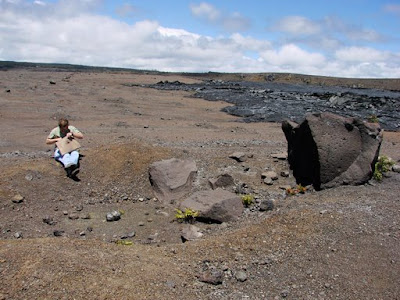The HVO has a wonderful account of the May 1924 eruptions here. Much of what they talk about, Don included in his tour, some of which I'll try to reproduce here (although there's no reproducing how wonderful a storyteller he is; if you ever get the chance to meet him, don't let him get away without talking about the history of geology at Kilauea).
To start, here's the scene of all the excitement; this was stitched together from photos I took during a gas sampling field trip.

The 1924 eruptions began in late April when the lava lake in Halema'uma'u drained, and the floor of the crater collapsed. This was followed by an earthquake swarm at the in the Eastern Rift Zone, near Kapo'o and Puna. The swarm subsided, but the crater floor continued to sink, going from ~115 m deep following the draining of the lake to more than 200 m deep. Avalanches were almost continuous, and enlarged the crater significantly. Finally, on May 11, the first explosions began to throw rocks and ash from the crater. These explosions went on until the end of May, and scattered debris in a large field all around the crater.
The part of the debris field we visited is across the road from the Halema'uma'u overlook. Here's the first of the craters, with Don Swanson for scale:



This surface forms when acid rain from the volcano dissolves SiO2 in the environment; the SiO2 is redeposited on the ground as opal, which cements the ash particles into a hard crust. Unfortunately, it's hardly gem-quality - but it's cool to know that you're walking on opal!
Many of the bombs in the debris field are very large, some of them weighing more than ten tons. This is the first example that we saw:

This particular bomb has some fascinating features. It's very dense, and it has a rind that shows miniature columnar joints, which means the rock was still hot when it landed.

It lacks a crater, which might lead someone to think that it was from the older debris field, but observers in 1924 noted that it was still hot when they encountered it. They concluded that the rock bounced or rolled away from its original impact site, which is now obscured. What I found impressive was the distance that this rock had traveled - hundreds, if not thousands of meters from the Halema'uma'u crater. It's not only the crater rim that's potentially dangerous, which is why park officials were very prudent to have closed the Crater Rim Drive (for that reason as well as the increase in gas output). Some of the observers of the 1924 eruption weren't so cautious:

We were a little more cautious in our observations than that photographer, who was in the process of picking up his camera and making a run for it.
As it turns out, Don enjoys geopuzzles as well. Here's a group of features that he invited us to speculate about:

They look like impact craters, but they're curiously lopsided, and they're not oriented toward the caldera. In fact, they weren't created by the volcano at all. Prior to the World War II, one of the fastest ways to get to Kilauea was to fly in, and this flat area served as an airstrip. After the attack on Pearl Harbor in 1941, these mounds were bulldozed onto the field to keep the Japanese from using the airstrip. (And to confuse future volcanology students, but I'm sure they kept that motive quiet at the time.)
Our last stop was at another large block on the debris field, this one better documented than the others. Here's a Don Swanson shot from 2006:

And here's a photo from May 22, 1924:

This block was thrown out of the caldera in an eruption on May 18, 1924, the same day that one of the victims of the 1924 eruptions, Truman Taylor, was fatally injured by explosion debris while retreating from the Halema'uma'u crater.
The recent explosion at Halema'uma'u is a fascinating new aspect of this episode of the Kilauea eruption. Not only did Pu'u O'o recently experience a flank eruption, which is a dramatic shift from the pali-cresting lava tubes of the past few years, but the main caldera also seems to be getting livelier, with a nearly four-fold increase in gas output and the first explosive eruption in more than 80 years. It's perhaps an indicator of a change in the magma chamber beneath the caldera, and it will be interesting to see if it leads to more explosions, or even a new lava lake in Halema'uma'u.
In which case I will be buying plane tickets, because there's no way I'm gonna miss that.









1 comment:
great summary and photos ... I enjoyed it
Post a Comment